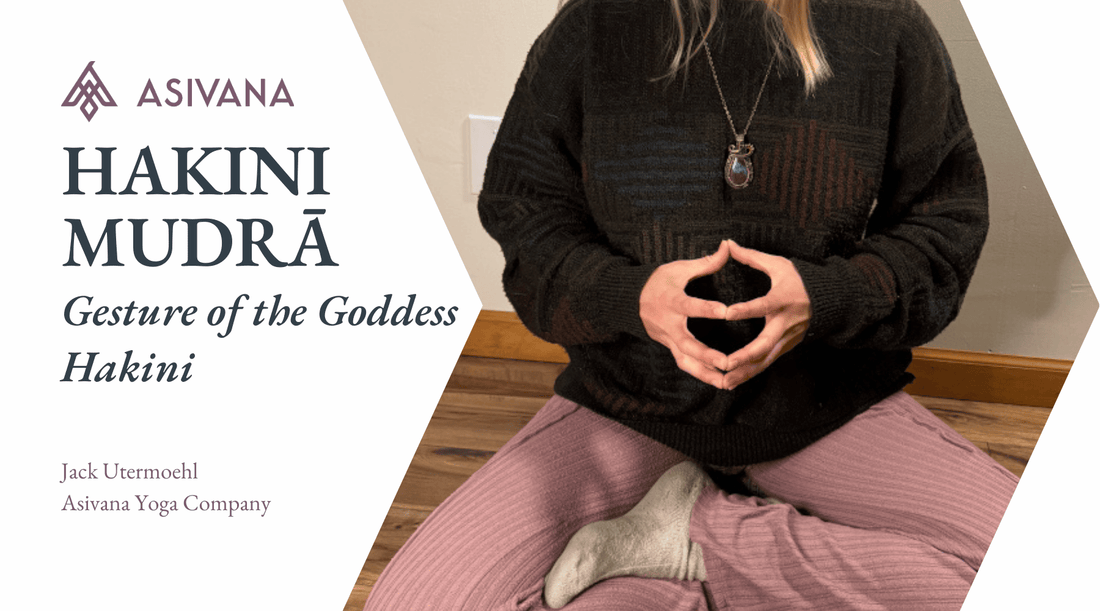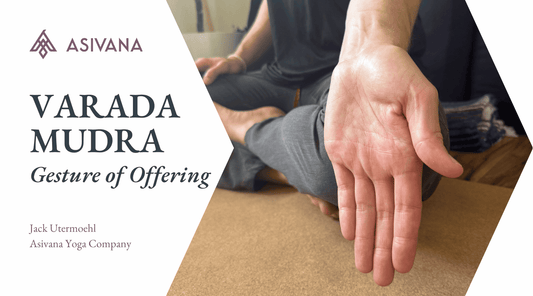
Hakini Mudra - Gesture of the Goddess Hakini
Jack UtermoehlShare
Hakini Mudra (Gesture of the Goddess Hakini)
Sanskrit Name: Hakini Mudrā - हाकिनी मुद्रा
English Translation: Gesture of the Goddess Hakini
Phonetic Spelling: HAH-kee-nee Moo-Drah
Hakini mudra is named after the goddess Hakini, who is associated with the power of the mind and intuition.
This gesture is primarily used to enhance cognitive function, concentration, and memory. By uniting all five fingers, this mudra helps balance the right and left hemispheres of the brain, promoting mental clarity and a sense of calm focus.
It is ideal for students, professionals, and anyone looking to improve their mental faculties.
Hakini mudra is also closely connected to the Ajna (third eye) chakra and Manipura (solar plexus) chakra.

Instructions to Perform Hakini Mudra
Find a comfortable seated or standing position, ensuring your spine is straight and your body relaxed. Begin by taking a few slow breaths to center yourself.
Hand Position: Bring the tips of all five fingers from both hands together, with the palms facing each other but not touching. Keep the hands at solar plexus level, in front of Manipura chakra.
Posture: Sit in sukhasana (easy pose) or padmasana (lotus pose) for a grounded experience. Alternatively, you can stand in tadasana (mountain pose) to feel rooted and balanced.
Breathing Technique: Inhale deeply through the nose, allowing your breath to fill your lungs and expand your chest. As you exhale slowly, focus on the unity of the fingers and the connection between your mind and breath.
Duration: Practice Hakini mudra for 5 minutes, especially during moments when you need enhanced focus or concentration. You can also use it during meditation or while listening to a lecture.
Benefits of Hakini Mudra
Hakini mudra is ideal for enhancing concentration, memory, and mental clarity. It is commonly used to balance mental energy and connect the mind and breath.
Physical Benefits: Increases oxygen flow to the brain, improving cognitive function and reducing stress. Helps balance the body’s energy by empowering Manipura chakra.
Mental Benefits: Sharpens focus, improves memory, and supports problem-solving skills by balancing the brain’s hemispheres.
Emotional Benefits: Calms the mind and relieves stress, promoting a sense of mental peace and centeredness.
Spiritual Benefits: Enhances intuitive insight and connects the practitioner to deeper self-awareness by stimulating the third eye chakra.
Capture your insights and deepen your connection with our Yoga Journal.Elevate Your Mudra Practice
Symbolism and Meaning of Hakini Mudra
Hakini mudra represents the union of mind, intuition, and breath. By bringing the fingers together, this mudra creates a symbolic bridge between the left and right hemispheres of the brain, creating unity. In yogic philosophy, Hakini is a goddess associated with power over the mind, and this mudra is a direct invocation of her wisdom and insight.
The practice of Hakini mudra helps stimulate the Ajna (third eye) chakra, where intuition, foresight, and clarity reside. By focusing the mind, this mudra allows for deeper meditation and heightened awareness.
When to Practice Hakini Mudra
Hakini mudra can be practiced any time you need to enhance focus, improve concentration, or calm your mind. It is particularly useful during study sessions, before important meetings, or when making decisions.
Use this mudra during moments of mental fatigue or stress to rejuvenate your mind and reconnect with your intuitive abilities. It can also be integrated into how you listen to and process talks and lectures.
A duration of 5 minutes is recommended, but more can be useful if listening to a longer talk.
Contraindications for Hakini Mudra
Hakini mudra is safe and accessible for all practitioners. There are no known contraindications for this mudra.
Additional Insights on Hakini Mudra
Affirmations: "I focus my mind with clarity and calm." / "I connect to my intuition and inner wisdom."
Visualization: While holding Hakini mudra, visualize a bright, glowing light between your hands, representing the power of Manipura drawing towards the unity of your mind and intuition in Ajna chakra. Let this light expand to fill your entire being with clarity and calm.
Associated Chakras: Hakini mudra primarily activates the Ajna (third eye) chakra using the power of Manipura (solar plexus chakra).
Paired Asanas: Works well with seated postures like sukhasana (easy pose) or vajrasana (thunderbolt pose) to enhance grounding and focus.
Related Pranayama: Pair Hakini mudra with deep belly breathing to stimulate mental clarity and enhance concentration.
Meditation Techniques: Hakini mudra is ideal for mindfulness meditation or breath awareness practices, where focus and concentration are emphasized.
Variations and Modifications
Alternative Hand Positions: None
Adaptations for Beginners: Beginners may start by holding Hakini mudra for shorter periods, such as 2 minutes, and gradually increase the time. Resting the elbows on a cushion can provide additional support during longer sessions.
—— 🕉 ——

Personal Insights
I love Hakini mudra. I commonly perform this mudra when I'm listening intently and absorbing information I find valuable such as during a yoga workshop or retreat.
I find that Hakini's third eye activation engages my focus and keen cognition of the content I'm listening to. This mudra also seems to trigger a deeper seeding of memory in my experience.
I'd highly recommend trying this mudra during any yoga festival, lecture, lesson, or workshop you attending.
Hakini mudra is typically held at solar plexus (manipura chakra) with fingers generally pointed away to form the 'ball' of energy between your hands. Some uses may point the fingers downward or upward. This typically has minimal impact on the function of Hakini mudra however it may be more comfortable to hold. Upward may evoke a more ego, material, sense of power.
Let me know your experience in the comments below.












1 comment
The top picture shows fingers pointing downwards , the bottom picture shows fingers pointing away from body and in fact there are other hakini mudra pictures where fingers point upwards so a bit confused as to which one should be practiced and if benefits differ based on direction of fingers eg down , away, up etc.